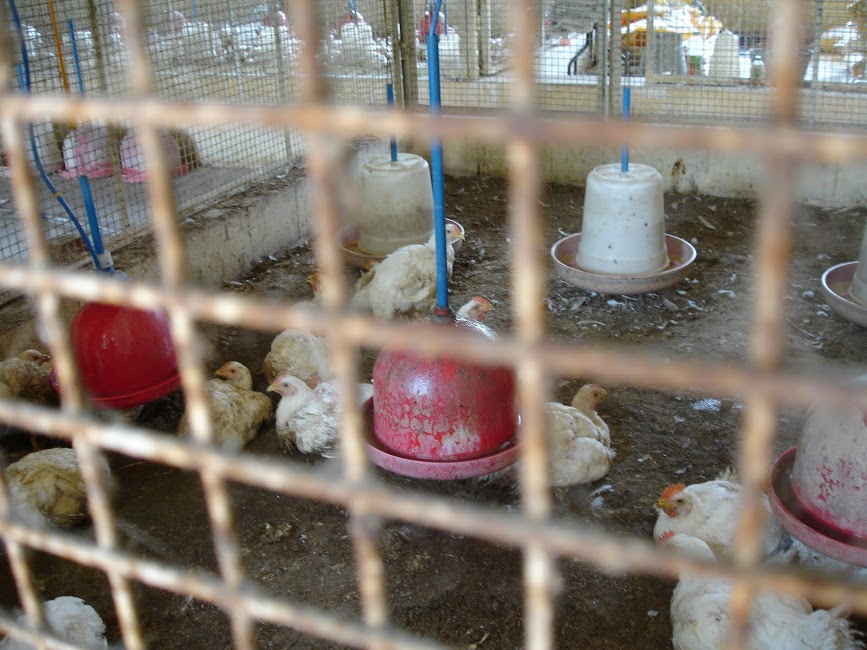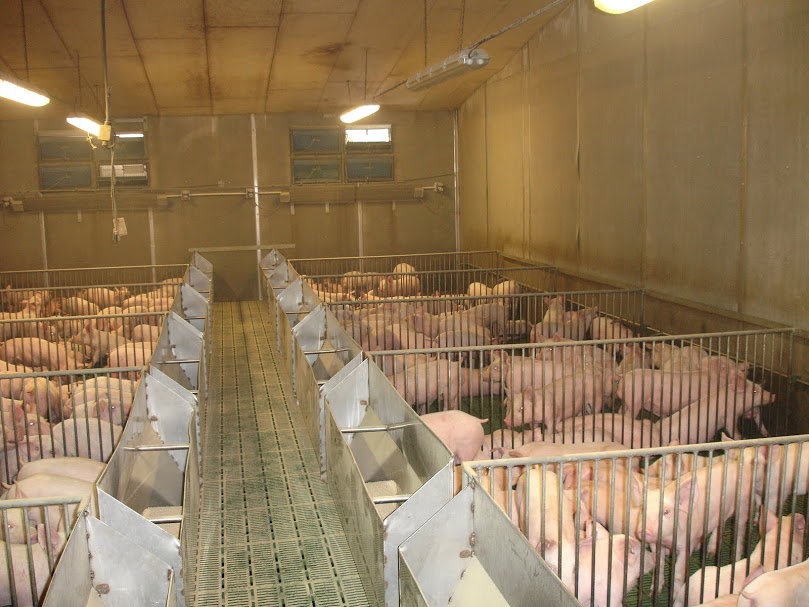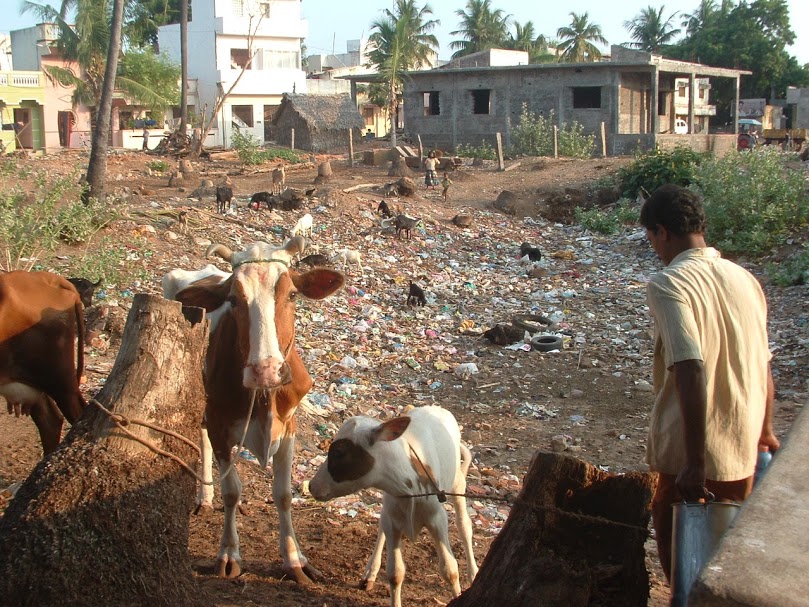Farm animal abuse
Despite evidence that animals can emotionally and physically experience the world in much the same way that we do, we continue to treat them as mere commodities that can be exploited for our benefit. It is the desire to maximise profit and fill supermarket shelves, which has led to such inhumane treatment of farm animals. Because it is less expensive than more humane alternatives, we accept the practice of keeping animals in abysmal concentration-camp style factory farms, in zoos, in testing facilities, in pet stores and cages of all sorts. In many of these facilities, they lead bleak lives, with no stimulation, unable to perform their natural behaviours.
Besides the Indian subcontinent, Asian countries have been traditionally dairy-free. Most indigenous tribes worldwide do not consume milk. But today many believe that cows naturally produce milk for human consumption. However, like all mammals, cows produce milk to feed their own young. Repeated pregnancies are required for continuous milk production.
Traditionally here, cows were raised as members of the family and revered as a mother because they gave milk. Calves were first given their share of milk. Female calves were raised as milk producers and male, to work in the fields. In the absence of refrigeration milk did not have commercial value. Today every part of the cow is of commercial value from the cow dung and urine to leather and bone.
For farm animals the journey to the slaughterhouse entails further suffering – they are packed onto lorries, squashed together and often shipped abroad for slaughter in foreign abattoirs where their short lives are ended in barbaric ways. Broken bones, and wings, injuries and sickness over and above the lack of food water and rest. Fear, pain, frustration, despair, hopelessness are just some of the negative emotions we are guilty of causing them.
We are happy to attribute feelings to our pets, but for the animals we eat or use in other ways for our material gains, we create an entirely new set of rules. This disconnect, for many, is an attempt to continue practices that are inconsistent with our values.
Some of the following anecdotes are adapted from Dr. Nandita Shah’s account of her one-month internship at Farm Sanctuary, an organization in upstate New York (USA), whose mission is to raise awareness about the plight of farm animals:
Farmed chicken
Abnormal growth leading to sudden death
What many of us do not know is that there are two types of chickens that are raised, those for meat, and those for eggs. The chickens raised for meat are bred to grow quickly and develop a high body mass. They typically grow from chick to slaughter size in just 6 weeks, twice as fast as naturally-bred chickens would. Their breasts are so disproportionately heavy that they find it difficult to support their own weight. Once they reach maturity, it is not uncommon for them to die suddenly of a heart attack while running due to the excess weight.
Cramped space
With the egg laying variety, the male chicks are separated from their sisters and discarded. The egg industry has no incentive to keep them, as they are viewed as taking up space that they are not worth. Egg laying females are kept in wire cages a mere 20 inches wide, five to a cage, with no place to stretch their wings, move or even walk.
Cruel factory procedures
To prevent them from pecking each other, their beaks are cut off without any anaesthesia soon after birth. The beak is a very sensitive part and many die as a result of this cruel procedure, but this is considered a natural loss by the industry. The claws on their feet are often cut off for the same reason, leaving their feet and legs deformed. They are also kept in the dark for most of their lives to reduce the aggression and to make them lay more eggs. These chickens have been bred to lay about 250 eggs a year, a tenfold increase from what they would produce in nature. As a result of the ensuing calcium depletion, their bones become brittle. When their egg production decreases, in about a year, they are taken to slaughter and used as chicken soup or pot pies, where their depleted bodies are ground or otherwise dismembered so that their bruises go unnoticed. The situation with the chickens is similar in India—rural India is now dotted with “poultries”, factory farms for chicken.
Farmed pigs – Inhuman factory conditions and treatment
The pigs are usually slaughtered at an age of six months, when they weigh about 250 lbs! Again, these animals have trouble supporting their weight. They can hardly walk and often suffer extremely painful arthritis and deformities in their limbs. They are abused in factory farms where sows are kept in gestation crates all their lives with no room to move. To the industry, they are just piglet producing machines. They are allowed to nurse their piglets while still confined for 2 weeks after which the piglets are torn from them to be fattened for slaughter. The sows are immediately impregnated to begin another 4-month cycle. Pigs normally form strong bonds with their young for two years, but because it is not profitable, they are deprived this natural bond by the industry. Many of these pigs raised in this captivity demonstrate extreme discomfort, but as long as they produce piglets, this goes ignored. When their bodies are worn out – which doesn’t take long – they, too, are dragged to slaughter. At the time of their demise, they are often too weak to even walk. If allowed to live out their life, these animals can live up to twenty years.
Farmed sheep
In nature, sheep shed their wool seasonally, but these sheep have been modified to produce so much wool that they cannot shed it themselves. As a result, they must be sheared by humans. This abundance of wool causes them to have folds in their skin, which are prone to abscesses. If unchecked, these abscesses can lead to death.
Farmed cows and calves
Oxytocin Injections
Cows are subjected to daily oxytocin injections causing excruciating labour-like pains, in the hope of increasing the milk flow.
Milking machines – injurious and sometimes fatal
Milking machines, if used, cause injuries and bleeding of the udder. They occasionally give electric shocks causing considerable discomfort, fear and impaired immunity, sometimes leading to death.
Reduced Life span : Chain of Artificial Insemination-Too many pregnancies-Burnout-Slaughter
Cows may produce milk for two, even three years when nursing their calves. In the absence of the calf they dry earlier. To keep the milk flowing cows (and buffaloes) are artificially inseminated within 2 months of giving birth. The animal has to produce milk while pregnant. The result, she is spent after about 4 pregnancies and must be retired (slaughtered). The average natural life span of a cow is 26 years yet today most live no more than 6 – 8 years.
Inhuman living conditions
Dairy cows are repeatedly impregnated since they produce milk only for their young (and not continuously as many people believe). They are bred to produce 10 times the normal amount of milk; even so, male calves are deprived of any milk since they are useless to the industry. Dairy cows are kept in small spaces in barns most of their lives, since it is more productive to milk them without letting them move around. In India it is a common sight to see cows tied to posts with short ropes spend hours in the heat of the sun, on the roadsides without water. Others spend their lives in overcrowded city shelters standing on concrete floors in their own excreta, instead of in fields. They get very little fresh air and exercise resulting in widespread disease. Many of Mumbai’s cows suffer from tuberculosis and mastitis. Pasteurization does not kill the TB bacilli, which may be passed to the consumer. Bullocks often collapse while transporting large loads in the hot sun without rest, food and water.
Feed on Garbage
In India, cattle are also left to roam and find food themselves. They feed on roadside garbage supplemented with some feed by their owners. Many die prematurely from stomachs obstructed by plastic bags.
Mastitis
Most cows suffer mastitis due to their unusually large udders. This disease not only harms the animals, it harms anyone who attempts to live off their milk. The average glass of milk contains seven drops of pus! Antibiotics are a part of the feed of these cows, and are intended to prevent a fulminating infection. These drugs are also excreted in their milk along with large quantities of dioxins since there is no regulation on pesticides for animal feed.
Farmed cows and calves
Calves are deprived of their share of milk. Newborn male calves are largely unwanted. The male calves are sold often on the very day they are born to the veal industry. They are sent to slaughter, or sent out to fend for themselves, or tied to a pole and allowed to die slowly of starvation. In India, their carcasses are collected and used by the Kora Kendra (an institute which makes leather goods only out of leather from animals that have died natural deaths for those who are averse to killing) to make ‘ahimsic’ leather products. There, they are confined in crates so that their muscles do not develop. They are fed an iron deficient feed for six weeks in order to produce the tender white meat known as veal. In India, where veal is not so popular, these calves are torn from their mothers and tied outside the dairies to starve to death. This slow painful death takes about seven days. Some male calves have their stomachs slit soon after birth, while they are still alive, to make rennet for the cheese industry. In India this is supposed to be banned in favour of microbial rennet. We were taken to a stockyard where we saw hundreds of newborn calves being sold. We were forbidden to take any photos there. It would not be a good advertisement for the industry. Most places would not allow visitors. It was heartbreaking to think that these helpless babies didn’t have even one day to spend with their mothers. The mother cows suffer from intense grief and can often be heard crying for days. Female calves are brought up to join their mothers as milk producers. Even ‘goshalas’ in India, built for the welfare of cows, separate the calf from its mother in order to milk her.
One of the rescued cows at Farm Sanctuary, who gave birth there, rejected her calf, Robin, when she was born. We thought that it was probably because she had been deprived of so many calves that she didn’t want to get attached. In a span of a week, once she saw that her calf was not taken away from her, she began to care for her in the most loving way.
Beef cattle
So what about the cows that we do see in the fields? These are beef cattle. As with chicken, there are cows that are bred for milk, and cows bred for beef. The beef cows are bred to grow extra fast and fat for slaughter. They are fed various hormones and growth enhancers to quicken the process. Their last feed before they are sent to slaughter is a different feed called finishing feed. It contains cement dust and such, to increase their weight, as they will not have to digest it anyway. Those extra pounds give the broker a few dollars more.
Overpopulation of cattle
Like other species, cattle are ecologically beneficial only when their numbers are in balance with the rest of the ecosystem. With 2.4 percent of the world’s land area and 16 percent of the world’s human population, India has 20 percent of the world’s livestock population! (Animal Citizen Jan – March 2004, page 23) In search of fodder humans and cattle have encroached into forests and destroyed most of them. Today our national parks face a human-wildlife conflict. Barely 4.6 per cent of our land remains protected forest. If the system is to regenerate and support wildlife before desertification takes place, livestock numbers must come down drastically. The increase in cattle population is totally unnatural and is due to artificial insemination.
Fishing
Billions of fish are caught each year. All too often unwanted species are also caught and left to die without reason. Fish are sentient creatures and feel pain. They die by suffocation which is extremely painful and which can sometimes take many minutes. Today Canada is killing thousands of baby seals brutally by clubbing because they are competing with Canadian fishermen for the catch! So a fish eater is indirectly responsible for more deaths than the ones he sees on his table alone.
Commercial fishing has decimated the aquatic environment. Shrimp nets kill countless sea turtles. Dragging trawlers kill all life including the plant life that fish thrive on, at the bottom of the ocean. Overfishing is causing extinction of species that are fished, as well as those that depend on these fish for food.
Today, fish are also victims of the factory farming system. They are often farmed in floating cages or in artificial ponds. Because of the large numbers involved, and the restricted movement, disease spreads rapidly, often also to wild specimens, and the water gets highly polluted. Each vegetarian or vegan will save at least half a ton of fish in a lifetime.
Slaughterhouses
Slaughterhouses are some of the worst workplaces. Most animals are slaughtered in front of each other with no stunning. In many states in India, cow slaughter is forbidden but keeping an animal that is non productive is unaffordable. These animals are clandestinely slaughtered without stunning, or are transported under abysmal conditions to distant slaughter-houses and often slaughtered in front of one another. The workers are poor, often illiterate, and sometimes children. They are treated almost as callously as the animals dying by the billions in those same facilities. The pay is low, turnover is high, and injuries and illnesses are frequent and often severe.


